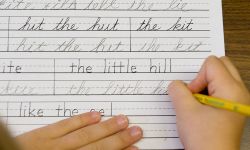Tensions mount as 3 Michigan school districts hesitate to open classrooms

CORRECTION: An earlier version of this article incorrectly stated that most Michigan counties are considered safe for face-to-face instruction based on coronavirus safety thresholds established by the Centers for Disease Control and Prevention. That is not true. Bridge Michigan misinterpreted how CDC guidelines calculated virus rates. The article has since been corrected. Bridge Michigan regrets the error.
It was an email Monday evening from the Ann Arbor Public Schools superintendent that finally broke Nicholas Bagley.
The email, from Superintendent Jeanice Kerr Swift, informed families that Tuesday would be a snow day.
“We will call #virtual snow day tomorrow,” Swift wrote. “Take a break (from) the screen, read a book & take good care!”
Bagley’s two children, like all 18,700 students in Michigan’s fourth-largest school district, have been learning remotely since last March. The idea that his kids shouldn’t get the lessons they recieve on a normal, virtual-learning day because of snow drove the University of Michigan law professor to a Twitter tirade.
Parents are “quivering messes because they haven’t had their kids in school for nearly a year and are at the ends of their ropes,” Bagley tweeted. “Also, we just had a four-day weekend (students were off Friday and Monday). My kids have played in the snow! They’ve read books! THEY’VE HAD A BREAK. They don’t need those things right now. They need school. We need school.
“School is not optional,” Bagley continued. “It’s the most important gift we can give our kids. We need to find a way to get back to school immediately. We shouldn’t be looking for excuses to take what little school exists away.”
Tensions are flaring in Ann Arbor and a dwindling number of Michigan school districts that still have no dates set to welcome back students to classroom settings.
Despite declining COVID-19 cases and the urging of Gov. Gretchen Whitmer to return to in-person learning, three large districts — Ann Arbor, Lansing and Kalamazoo — have not set return dates and remain fully online as they have been since March 2020.
Whether classrooms in any of those districts open at all in the current school year is an open question. Kalamazoo Public Schools announced last week that it would remain fully virtual through the end of the school year. Ann Arbor Public Schools board declined to set a return date again this week, and Lansing School District is awaiting the installation of ventilation systems and teacher vaccinations before making a decision.
Under new Centers for Disease Control and Prevention guidelines for safely reopening schools, 49 of Michigan’s 83 counties are considered at substantial (11 counties) or high (38) risk of transmitting the virus. The CDC cautions schools in those counties to limit or avoid face-to-face instruction.
Washtenaw County (Ann Arbor) falls in the “high transmission” category based on its rate of 123 new cases per 100,000 per week, even though the county has seen just 2.3 percent of tests come back positive in the past week. The CDC standards suggest all-virtual schooling for districts in these counties.
Ingham County (Lansing) is among those counties falling into the “substantial” transmission risk group because it is averaging 91 cases per 100,000 per week. The CDC recommends hybrid learning and reduced face-to-face for these districts.
Another twenty-six counties are in the “moderate” risk category, with the most severe restriction being on sports and extracurricular activities. The CDC suggests maintaining six feet between participants. Detroit and the large counties of Oakland and Macomb fall into this category.
Kalamazoo County (48 cases per 100,000 per week) falls in the “moderate” risk category.
Nine Michigan counties, including six in the Upper Peninsula, are in the “low” transmission category. The CDC still suggests schools in these counties continue to use masks and maintain six feet of separation.
CDC ratings are meant as guidelines for local schools, not mandates.
In January, 35 percent of Michigan’s traditional public school districts and charter schools enrolling about 500,000 students offered only remote learning. Many of those districts have since begun offering in-person learning options or set start dates. Some were waiting for the beginning of their second semester, which typically starts in late January. Others were nudged toward reopening by Whitmer, who in January urged schools to unlock their classrooms by March 1.
“The value of in-person learning for our kids is immeasurable, and we must do everything we can to help them get a great education safely,” Whitmer said at the time.
The governor’s request wasn’t a mandate but it reflected a growing consensus of the importance of getting students back in classrooms. President Joe Biden also has pushed for face-to-face instruction amid mounting scientific evidence that in-class learning has not led to a major spread of the coronavirus when basic safety protocols (face masks, hand-washing, social distancing, etc.) are followed.
A Michigan State University study found in-person instruction is not linked to an increase in COVID-19 cases when there are low levels of virus cases in the community, but that schools can increase the spread when case numbers are high.
Michigan coronavirus cases have been in steady decline since the beginning of January, offering more momentum for reopening classrooms.
In Lansing, School Board President Gabrielle Lawrence told Bridge Michigan Tuesday that the 10,600-student district is “watching and tracking the COVID data and metrics before implementing our return to school plans and exact dates.”
Lawrence said school buildings are in the process of adding air filtration units and UV cleaning equipment. Lansing teachers have been the last in Ingham County to get vaccinations, because the county health officials have prioritized vaccination appointments for educators in districts that are currently offering in-person instruction or have dates set for return.
“We take the health and safety of our incredible staff very seriously and will not make decisions that unnecessarily endanger them,” Lawrence said.
Kalamazoo Public Schools, with 12,800 students, is believed to be the first district in the state to announce that it will stay fully remote for the remainder of the school year. School officials acknowledged that, based on science alone, school buildings should reopen.
The decision was made to stay fully remote for the rest of the school year anyway, because the majority of parents, teachers and staff said they preferred that option.
In recent surveys, 53 percent of parents preferred staying fully remote, along with 79 percent of staff and 83 percent of teachers.
“Our top priority for this unprecedented school year has been and remains the health and safety of our students and employees,” Kalamazoo Superintendent Rita Raichoudhuri told the school board Feb. 11, according to M-Live.
Raichoudhuri declined to comment for this article. School board president Patti Sholler-Barbour referred questions to the district administration office, which did not return a request for comment.
In Ann Arbor, some parents, including a group of doctors, have pushed for months for school buildings to reopen. In Washtenaw County, the COVID test positivity rate has dropped from 7 percent in November to 2.3 percent now, below the statewide average. Average daily cases per 100,000 have been cut in half over the same period, from 40 to 19.
Despite the dropping coronavirus numbers, Ann Arbor Superintendent Swift told Bridge in an emailed statement that she continues to be concerned by the presence of the more contagious B117 variant of COVID-19 in the community. Washtenaw County has the most diagnosed cases of the variant in the state, with many connected to the University of Michigan.
Also, Washtenaw County had a lower teacher vaccination rate as of last week, a Michigan Education Association survey indicated.
According to the survey by the state’s largest teachers’ union, nearly two-thirds of Michigan teachers had already received their first vaccine dose or were scheduled to get their shot. Washtenaw County had the lowest vaccination rate, at 25 percent.
Bagley, the Ann Arbor parent, said he hasn’t complained publicly about online learning in the past, but Monday’s snow day text was the last straw.
“The thought that a snow day is appropriate after almost a full year of being out of the classroom makes me incandescent with rage,” Bagley told Bridge Michigan. “It goes to show how little the district cares about the concerns of parents and the students who are struggling with virtual learning.”
Bagley is the father of a 13-year-old son and an 11-year-old daughter. He said homebound learning has been “mixed” for them.
“They need contact with classmates,” Bagley said. “They need to be in a room with their peers and not just be looking at a screen all day.”
Bagley said he understands the safety concerns of teachers, but believes Ann Arbor and other districts that aren’t yet allowing in-person learning options need to also consider the concerns of families.
“I think all of us have seen our kids struggle with the lack of in-person instruction and the lack of being able to socialize with kids,” Bagley said. “There are a lot of parents who feel this way but our voices aren’t cutting through.”
With school out, Bagley said he asked his daughter Tuesday to work on math online or find something else to “expand her mind.”
“She looked at me like I’d asked her to pull out her fingernails,” Bagley said. “She said, ‘It’s a snow day!’”
Bagley sighed.
“We are working parents. You’re juggling child care responsibilities and work responsibilities and at the end of the day, you just want to collapse.
Michigan Education Watch
Michigan Education Watch is made possible by generous financial support from:
Subscribe to Michigan Education Watch
See what new members are saying about why they donated to Bridge Michigan:
- “In order for this information to be accurate and unbiased it must be underwritten by its readers, not by special interests.” - Larry S.
- “Not many other media sources report on the topics Bridge does.” - Susan B.
- “Your journalism is outstanding and rare these days.” - Mark S.
If you want to ensure the future of nonpartisan, nonprofit Michigan journalism, please become a member today. You, too, will be asked why you donated and maybe we'll feature your quote next time!






